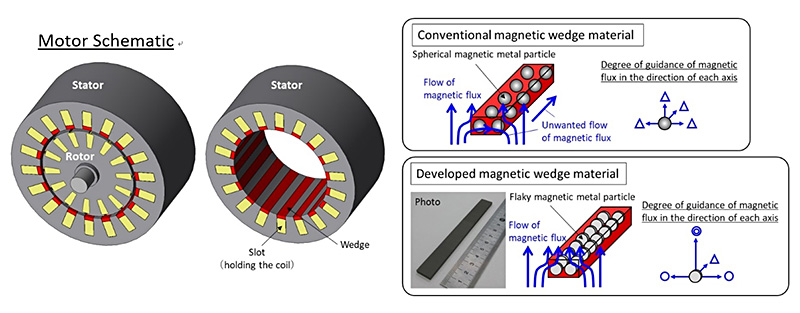Toshiba’s new magnetic material said to offer heightened efficiency
January 5, 2021
Comparison between magnetic flux in conventional magnetic wedge material and the new material developed by Toshiba (Courtesy Toshiba Corporation)
Toshiba Corporation, Tokyo, Japan, has developed a new magnetic material with characteristics said to deliver major improvements in motor efficiency at minimum cost, and with the potential to win significant reductions in power consumption. Greater efficiency and reduced power consumption in motor engines are important factors which are both necessary toward achieving a low-carbon future.
Motors account for approximately half the world’s electric power consumption. As a result, explains the company, any advance that can improve their efficiency promises major benefits to society as a whole, and will help to promote the shift to a carbon-free economy worldwide.
Toshiba’s new material is said to greatly boost motor energy conversion efficiency when used to manufacture the wedges in the motor, particularly in medium to large induction motors. The material can reportedly be installed at minimal cost with no need for design changes.
Through testing in an induction motor in railway rolling stock drive systems, Toshiba has confirmed an efficiency increase of 0.9%, with an improvement approaching the efficiency of permanent magnet synchronous motors. The material also offers excellent heat resistance, suiting it for applications such as railway rolling stock, automobiles, robots, and industrial and medical equipment.
If used in all motors operating worldwide today, with the same level of improvement in efficiency recorded by Toshiba, the company believes that the material could allow for the elimination of ten 1 GW power plants.
Wedges in motors prevent motor coils from falling out of their slots. They are normally made of non-magnetic material, but the use of magnetic material has been found to guide magnetic flux toward the wedges, improving energy conversion efficiency.
However, the conventional magnetic material used as the wedges is composed of spherical magnetic metal particles with insufficient control of the magnetic flux, causing leaks in unwanted directions. The conventional magnetic wedge material itself also has a high magnetic loss and low heat resistance, making it unsuitable for railway rolling stock and other applications that require high heat resistance.
The unique characteristics of Toshiba’s new magnetic material are said to deliver excellent control of magnetic flux, ultra-low magnetic loss, and high heat resistance. The material is composed of flaky magnetic metal particles that have different magnetic properties depending on the direction of the magnetic field, and ultra-low magnetic loss. When this material is used to produce a magnetic wedge, magnetic flux can be efficiently guided in the specific direction desired, reducing energy loss and significantly improving energy conversion efficiency.
Toshiba also found that compacting flaky magnetic particles with a heat-resistant binder heightens thermal stability, with barely any weight decrease, even when held in a hot, 220°C environment for a long period of time. This high heat resistance opens the way to a much wider range of applications for magnetic wedges.















